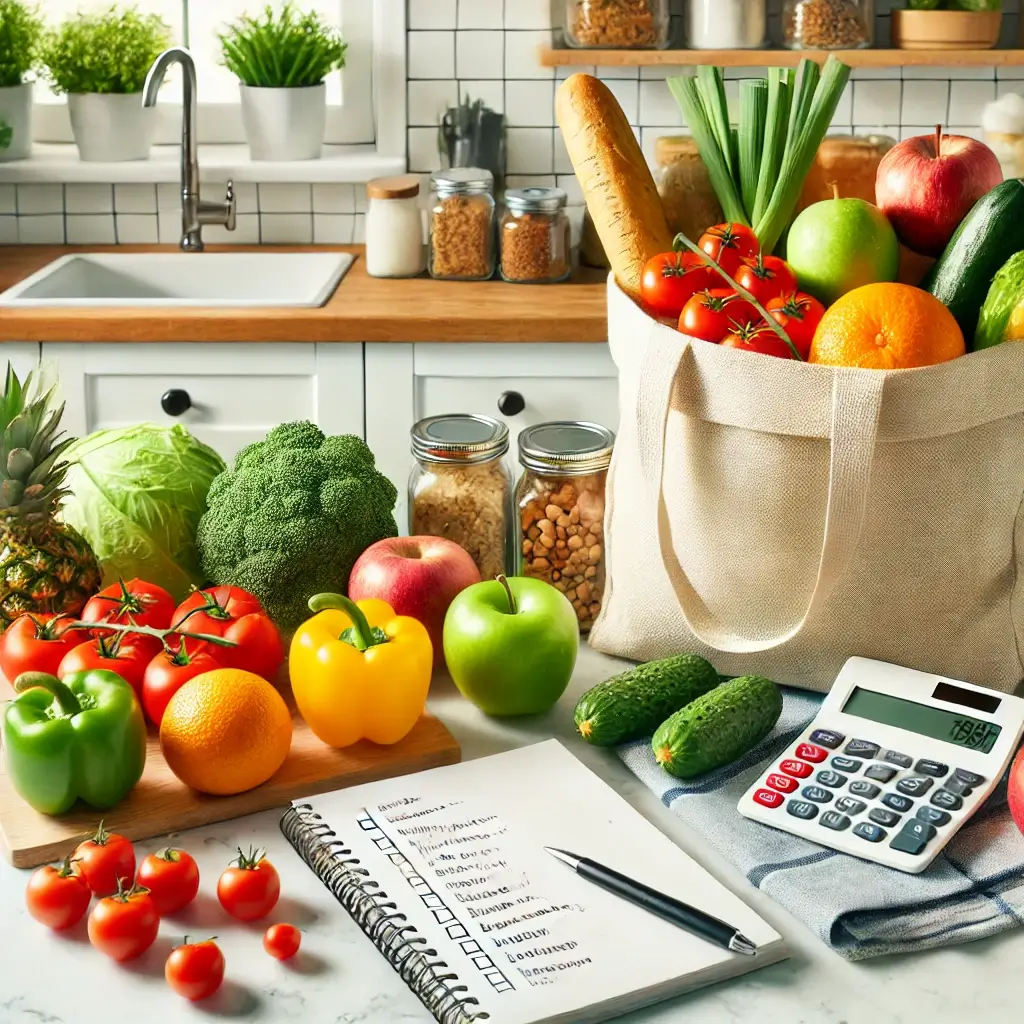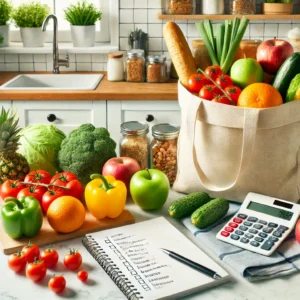How to Save Money on Groceries: The Ultimate Guide for 2025
Does your grocery bill feel more like a mortgage payment? You’re not alone. With food prices constantly on the rise, walking out of the supermarket feeling like you got a good deal can seem impossible. But what if I told you that you could cut your grocery spending by 20%, 30%, or even more, without resorting to a diet of instant noodles?
Saving serious money on groceries isn’t about luck or extreme couponing; it’s about having a strategy. It’s about shifting your mindset from a passive consumer to a proactive planner. For years, I was stuck in a cycle of impulse buys, wasted food, and budget-busting receipts. After implementing the system I’m about to share with you, my family now saves over $400 every single month—money that goes directly toward our real financial goals.
This comprehensive guide will walk you through a three-phase system: **The Pre-Shop Strategy**, **In-Store Tactics**, and **Post-Shop Habits**. By mastering these three areas, you’ll not only lower your bill but also reduce food waste, eat healthier, and eliminate the stress of weeknight dinner decisions. Let’s get started.

Phase 1: The Pre-Shop Strategy (Where 80% of the Savings Happen)
The biggest mistake most people make is walking into a grocery store unprepared. Your savings journey begins at home, in your kitchen. This planning phase is the most critical part of the entire process.
1. Give Your Money a Mission: Set a Goal
Why do you want to save money on groceries? “Just because” isn’t a strong motivator. You need a clear, compelling reason. Saving a significant amount on groceries starts with a specific target. It’s not just about spending less; it’s about reallocating that saved money towards something meaningful, like paying off debt or saving for a family vacation. This is where it helps to know how to set achievable goals, turning a vague idea like “save money” into a concrete plan like “save $300 a month for our Disney fund.”
2. “Shop” Your Kitchen First: The Inventory Audit
Before you even think about a list, take a full inventory of your pantry, fridge, and freezer. What do you already have? That half-used bag of quinoa, the frozen chicken breasts, the can of black beans—these are your starting players. Your goal is to build meals around what you already own. This single habit is the fastest way to slash your bill and prevent food waste.
3. Master the Meal Plan (The Right Way)
Meal planning is the cornerstone of grocery savings, but it doesn’t have to be rigid. Here’s a flexible approach:
- Theme Nights: Assign a theme to each night to simplify planning (e.g., Meatless Monday, Taco Tuesday, Pasta Wednesday, etc.). This narrows down your choices and makes planning faster.
- Plan Around Sales: Grab the weekly grocery store flyer (or check their app). Is pork shoulder on sale? Plan for pulled pork. Are berries a great price? Plan for smoothies and yogurt bowls. Let the sales dictate your menu.
- Plan for Leftovers: Intentionally plan one or two “leftover nights” per week. Or, plan to use leftover ingredients in the next day’s meal (e.g., leftover chicken from Sunday’s roast becomes Monday’s chicken salad).
Effective meal planning isn’t just about saving money; it’s a form of personal productivity. By dedicating an hour on Sunday to plan, you save precious minutes and mental energy every single weekday. If you’re looking to master this skill, learning how to manage time effectively is a game-changer that pays dividends far beyond the kitchen.
4. The Art of the Grocery List
Once you have your meal plan, create your grocery list. But don’t just jot things down randomly. Organize your list by the store’s layout (e.g., Produce, Dairy, Meat, Canned Goods, Frozen). This prevents you from running back and forth, which is when impulse buys are most likely to happen. And the most important rule: **if it’s not on the list, it doesn’t go in the cart.**
The Golden Rule of Planning
Never enter a grocery store without a clear meal plan and a detailed, organized list. This is your non-negotiable first step to taking control of your budget.
Phase 2: In-Store Tactics (Executing Your Plan)
You’ve done the prep work. Now it’s time to navigate the store like a pro. Your goal is to get in, get what’s on your list, and get out with your budget intact.
1. Understand Unit Pricing
The bigger package isn’t always the better deal. Look at the shelf tag for the “unit price” (e.g., price per ounce, per pound, etc.). This is the only way to make a true apples-to-apples comparison between different sizes and brands. A smaller container of oatmeal might have a lower total price, but the larger one might be significantly cheaper per ounce.
2. Shop the Perimeter
Grocery stores are strategically designed to make you spend more. The outer perimeter is where you’ll typically find the whole, unprocessed foods: produce, meat, dairy, and eggs. The inner aisles are home to the more expensive, processed, and packaged goods. Do most of your shopping on the perimeter to get healthier food for less money.
3. Look High and Low
The most expensive items and brand names are placed at eye level for a reason. Cheaper store brands and generic options are often placed on the top and bottom shelves. A simple head tilt can save you a surprising amount of money on items that are often identical in quality to their brand-name counterparts.
4. Be Strategic About Bulk Buying
Buying in bulk at stores like Costco or Sam’s Club can be a great way to save, but only if you do it right. Only buy non-perishable items you use consistently (paper towels, canned goods, pasta) or perishable items you can realistically use or freeze before they spoil (meat, cheese, bread). A 5-pound bag of spinach that goes bad is not a deal.
Phase 3: Post-Shop Habits (Protecting Your Investment)
You saved money at the store—great! Now, you have to avoid wasting it at home. Every bit of food that ends up in the trash is wasted money.
1. Meal Prep is Your Superpower
You don’t have to spend your entire Sunday cooking. Even simple prep makes a huge difference. Wash and chop your veggies, cook a big batch of rice or quinoa, and portion out proteins. When you’re tired after a long day, having these components ready to go makes it infinitely easier to cook at home instead of ordering expensive takeout.
2. Implement an “Eat Me First” Box
Designate a clear container or a specific area in your fridge as the “Eat Me First” zone. Put items that are nearing their expiration date, leftovers, and half-used produce in this box. It’s a constant visual reminder of what needs to be used up first, drastically cutting down on food waste.
3. Embrace Your Freezer
Your freezer is a time machine for food. Did you buy too many bananas? Peel and freeze them for smoothies. Is that fresh spinach about to wilt? Freeze it for soups or stews. Did you make a big batch of chili? Freeze it in single-serving portions for future lunches. Wasting food is wasting money, and the freezer is your best defense.
As an Amazon Associate, we earn from qualifying purchases. These tools are recommended because they directly support the money-saving strategies discussed in this guide and can pay for themselves over time.
Tools of the Trade: Smart Investments for Your Kitchen
The right tools can make meal planning, prep, and storage much more efficient, helping you stick to your new habits.

Glass Meal Prep Containers
Investing in a quality set of glass containers makes meal prepping and storing leftovers a breeze. Unlike plastic, they don’t stain or retain odors, and you can easily see what’s inside, reminding you to eat your leftovers before they go bad.
Check Price on Amazon
FoodSaver Vacuum Sealer Machine
For serious bulk buyers, a vacuum sealer is a game-changer. It removes air and seals food airtight, extending freezer life by up to 5 times and preventing freezer burn. This allows you to stock up on meat, cheese, and produce when it’s on sale without waste.
Check Price on Amazon
Magnetic Meal Planner & Grocery List Pad
Keep your plan front and center with a magnetic notepad for your fridge. Having a dedicated space to jot down your weekly menu and your shopping list makes the planning process a consistent, easy-to-follow habit for the whole family.
Check Price on AmazonFrequently Asked Questions About Grocery Savings
How can I save money on meat and poultry?
Meat is often the most expensive part of the grocery bill. Try buying cheaper cuts (like chicken thighs instead of breasts, or ground chuck instead of sirloin), purchase larger “family packs” and freeze portions, and incorporate one or two meatless meals per week using budget-friendly proteins like beans, lentils, and eggs.
Is it cheaper to use a grocery delivery service?
It can be, but you have to be disciplined. Delivery services are excellent for preventing impulse buys since you’re not physically in the store. However, you need to factor in delivery fees and tips. It’s often best for people who struggle with sticking to their list in-store.
How do I save on fresh produce without it going bad?
Buy a mix of produce with different shelf lives. Use delicate items like leafy greens and berries early in the week, and save heartier items like carrots, potatoes, and apples for later. Don’t be afraid to buy frozen fruits and vegetables—they are just as nutritious, often cheaper, and last for months.
Are warehouse clubs like Costco or Sam’s Club always worth it?
Not for everyone. They are worth it if you have a larger family, have ample storage space, and will genuinely use the bulk items before they expire. Before paying for a membership, do the math. Will your savings on staple items outweigh the annual fee?
Conclusion: It’s a Skill, Not a Sacrifice
Saving money on groceries isn’t about deprivation; it’s about intentionality. By adopting a strategic approach—planning before you shop, being smart in the store, and being mindful at home—you transform a weekly chore into a powerful tool for achieving your financial goals.
Start small. Pick one or two strategies from this guide and implement them this week. Once they become a habit, add a few more. Before you know it, you’ll be a savvy shopper who walks out of the grocery store with a full cart, a full wallet, and a full sense of control.


